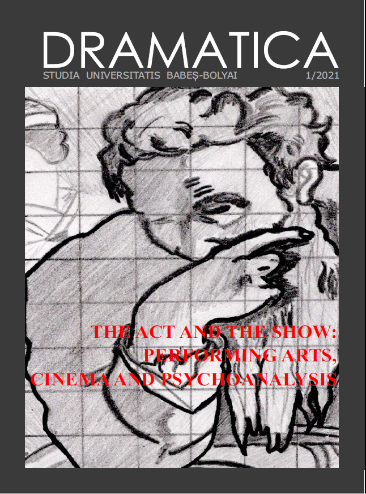Actes sexuels, horreur et sorcellerie au cinéma. La copulation avec le Diable : une perspective psychanalytique
DOI:
https://doi.org/10.24193/subbdrama.2021.1.07Keywords:
sex, sexual act, horror, witchcraft, psychoanalysis, Freud, cinema.Abstract
Sexual Acts, Horror and Witchcraft in Cinema. The Copulation with the Devil: a Psychoanalytical Perspective. This paper tries to approach, taking as a starting point a Romanian painting from the 18th century, a scene with a strong phantasmatic load: the sexual act of a woman, who is considered a witch, with the devil. Several films are analyzed: Häxan by Benjamin Christensen (1922), Rosemary’s Baby by Roman Polanski (1968), L’Anticristo by Alberto de Martino (1974), Angel above, Devil below by Dominic Bolla (1975). These films share some common features, important for the analytical process: the copulation with the devil, the presence of traumatized characters who are submitted to a psychological cure, the recycling of psychoanalytical vocabulary, especially “hysteria”, the problems with parental instances. In order to interpret these films, there is a coming back to Freud’s ideas on the Devil, as expressed in the letters to Wilhelm Fliess or in the study A Seventeenth-Century Demonological Neurosis (1923). The devil as an image of unconscious impulsions or as a substitute of the father are the main Freudian intuitions used here for an optimal interpretation of the chosen films.
References
Baxstrom, R. and T. Meyers. Realizing The Witch: Science, Cinema, and the Mastery of the Invisible. New York: Fordham University Press, 2015.
Creed, Barbara. The Monstrous Feminine. Film, Feminism, Psychoanalysis. London : Routledge, 1993.
De Lancre, Pierre. Tableau de l’inconstance des mauvais anges et démons. A Paris : Chez Jean Berjon, 1612.
De Lancre, Pierre. Tableau de l’inconstance des mauvais anges et démons. Paris : Aubier-Montaigne, 1982.
De Saint André. Lettres à quelques-uns de ses amis au sujet de la magie, des maléfices et des sorciers. À Paris : Chez Charles Osmont, 1725.
Dubal, Rosette. Psychanalyse du diable. Essai. Paris : Corrêa, 1953.
Elliott, Dyan. Fallen Bodies. Pollution, Sexuality, and Demonology in the Middle Ages. Philadelphia: University of Pennsylvania Press, 1999.
Freud, Sigmund. Une névrose démoniaque au XVIIe siècle, Traduit de l’allemand par Marie Bonaparte et Mme E. Marty. 1927. http://classiques.uqac.ca/classiques/freud_sigmund/essais_psychanalyse_appliquee/11_une_nevrose_demon/une_nevrose_demon.pdf
Freud, Sigmund. « Quelques considérations pour une étude comparative des paralysies motrices organiques et hystériques ». Archives de neurologie, n° 77 (1893). Source en ligne : https://gallica.bnf.fr/ark:/12148/bpt6k5658888d.r=paralysies+motrices+organiques+et+hyst%C3%A9riques.langFR%20ftp://ftp.bnf.fr/565/N5658888_PDF_1_-1DM.pdf
Freud, Sigmund. The Complete Letters of Sigmund Freud to Wilhelm Fliess, 1887-1904, Translated and Edited by Jeffrey Moussaieff Masson. Cambridge & London: The Belknap Press of Harvard University Press, 1985.
Gay, Peter. Freud, une vie, Traduit de l’anglais par Tina Jolas. Paris : Hachette, 1991.
Kermode, Mark. Dans les coulisses de L’Exorciste ou la petite histoire du film le plus terrifiant de tous les temps. Paris : Cinéditions, 2001.
Nathan, Tobie. Le Sperme du diable. Éléments d’ethnopsychothérapie. Paris : Presses Universitaires de France, 1993.
Onfray, Michel. Le Crépuscule d’une idole. L’Affabulation freudienne. Paris : Grasset, 2010.
Renoux, Christian. « Freud et l’affaire Haizmann ». Psychoanalytische Perspectieven, 20, 2 (2002) : 309-325.
Schreck, Nikolas. The Satanic Screen. An Illustrated History of the Devil in Cinema. London: Creation Books, 2001.
Stevenson, Jack. Witchcraft through the Ages. The Story of Häxan, the World’s Strangest Film, and the Man Who Made it. Godalming: FAB Press, 2006.
Tohill, Cathal and Pete Tombs. Immoral Tales. European Sex and Horror Movies 1956-1984. New York: St Martin’s Griffin, 1994.
Urtubey, Luisa de. Freud et le diable. Paris : Presses Universitaires de France, 1983.
Downloads
Published
How to Cite
Issue
Section
License
Copyright (c) 2021 Studia Universitatis Babeș-Bolyai Dramatica

This work is licensed under a Creative Commons Attribution-NonCommercial-NoDerivatives 4.0 International License.


